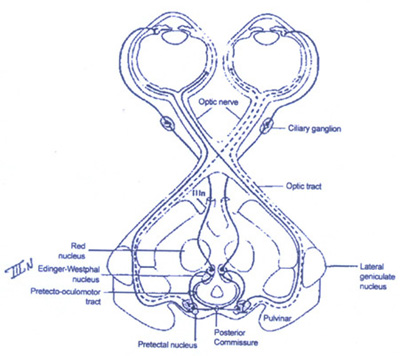Pupillary light reflex
Pathway for the pupillary light reflex:
-
When light first enters the eye, the light reflexes are mediated through axons from ganglion cells in the retina.
-
These impulses pass back in the optic nerve and decussate in the chiasm with the other visual fibers.
-
Pupillary fibers then leave the optic tract just before the lateral geniculate body, synapse at the pretectal area of the midbrain and then synapse bilaterally with the Edinger-Westphal nuclei.
-
The impulse then leaves the midbrain via the third cranial nerve to the ciliary ganglion, (Located within the muscle cone behind the eyeball).
-
After synapsing in the ciliary ganglia, the post-ganglionic fibers innervate the pupillary sphincter muscles to constrict the pupils.
